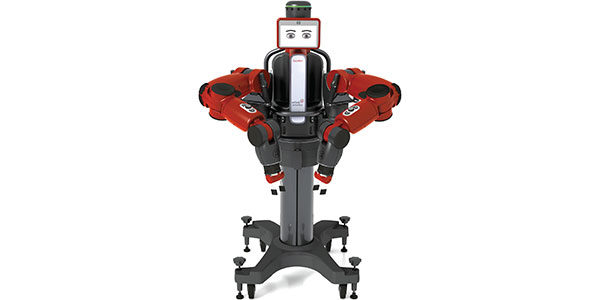R is for "robot": interview with Tom Bonkenburg

The Boston Consulting Group recently predicted that global sales for robots would reach $67 billion by 2025, with the industrial segment being the largest component of that market.
That prediction comes as no surprise to St. Onge Co. consultant Tom Bonkenburg, the leading expert on the use of robotic systems in distribution. A mechanical engineering graduate from the Rensselaer Polytechnic Institute, Bonkenburg has been fascinated by robots since he was a kid.
That fascination led him to a career in material handling. For the past 15 years, Bonkenburg's consulting efforts have focused on supply chain and warehouse design with a strong interest in custom automation and robotics within the distribution environment. He is currently a partner in the St. Onge Co. and heads up that firm's European office.
Bonkenburg recently discussed trends in robotics with DC Velocity Editor at Large James Cooke.
 Q: What's the current state of "robotics" in warehousing?
Q: What's the current state of "robotics" in warehousing?
A: The current state of robotics depends on your definition of the word "robot." For many years, we have seen robotic technology in the distribution environment such as AS/RS (automated storage/retrieval systems), AGVs (automated guided vehicles), shuttle systems, transfer cars, palletizers, Kiva, Symbotic, etc. These types of systems are mature, well understood, and installed in DCs around the world. However, if your definition of "robot" includes such terms as multipurpose, adaptable for different types of jobs, redeployable, or even "humanoid," then robotics is not very common in a typical warehouse environment.
Q: Any idea of the percentage of DCs that are using robotics in their operations?
A: This is a very difficult question to answer. Our research shows that 15 percent of warehouses are mechanized, and only 5 percent have true automation. Robotic systems would typically fall somewhere within these operations. The key point to note is that 80 percent of DCs are currently manual, creating a large potential opportunity for the future deployment of robotic systems if they could be made capable and affordable.
Q: What types of robotic systems are being used in warehousing, and for what purpose?
A: We often see robotic systems such as pallet AS/RS and end-of-line palletizers used in high-volume finished-goods warehouses that are attached to factories. These systems tend to operate for three shifts and handle a limited range of similar SKUs (stock-keeping units) but high volumes. The "goods to picker" technologies such as shuttles are being deployed in some direct-to-consumer piece picking operations with many small orders and large SKU bases.
Q: How about humanoid robotics? How soon do you think we'll see humanlike robots in warehousing?
A: Many of the traditional robotic-arm manufacturers are developing two-arm "humanlike" robots for use in assembly operations. These robots are still bolted down within an automated work cell like typical manufacturing robots. So far, few have been installed, but the interest in these new robots is very high. I believe this technology will first take hold in the manufacturing environment and then possibly move to the distribution side of the supply chain. This transition will likely take several years and will require a few more software, sensor, and cost-point breakthroughs. The good news is that several companies are investing serious money into advancing this technology.
Q: Do you know of any companies that are experimenting with humanoid robots in DCs?
A: One of the most impressive humanoid robots, Robonaut, was developed by NASA in cooperation with General Motors. They have experimented in the manufacturing environment but as far as I know not in the distribution environment.
Q: There's a company called Rethink Robotics that makes a humanoid robot called "Baxter." Where does development of that technology stand and is it being used in warehouses?
A: I am a big fan of Rethink Robotics and their underlying concepts. They have developed a low-cost, easy-to-use software-focused robot that works alongside human workers without fences or safety gates. Unfortunately, their first system, Baxter, is quite slow and has limited capability when it comes to warehousing and many manufacturing operations. There are rumors in the market that their second-generation robot will come out next year, and I am looking forward to seeing if future generations, such as versions three or four, would be more suited to distribution operations.
Q: Are any companies developing humanoid robots for use in warehousing?
A: Rethink Robotics has focused its development energy on manufacturing pick-and-place-type applications rather than on the more complex warehouse environment. This market strategy is similar to the path taken by other companies that are currently working on dual-arm robotics. The warehousing industry needs a robotic manufacturer to take the Rethink approach but focus on the distribution side of the supply chain.
Q: What's the biggest obstacle to putting robots in warehouses—cost or technology?
A: The truth is that both cost and technology are currently barriers to bringing robots into the warehouse. A few fundamental breakthroughs are necessary to both improve capability and reduce cost. The good news is that mini robotic breakthroughs are happening every year, and their frequency is increasing rapidly. The future path to commonplace robotics will depend on low-cost sensors and inexpensive but massive computing power. Anyone who used to have a rotary phone and now has an iPhone knows that those two key ingredients improve rapidly! I believe that all supply chain professionals should watch the robotics space because we will all be amazed how fast it will change.
Q: What's the biggest opportunity for using robots in warehousing?
A: When looking forward to the next likely breakthroughs in robotic technology, I feel that robotic industrial trucks, similar to but more advanced than those made by Seegrid, will be the true entry point for more widespread use of robotics in the warehouse. A truly functional fully robotic forklift could find immediate application in almost any warehouse. If you look at the recent breakthroughs in self-driving cars by companies such as Google, GM, BMW, Audi, etc., it is not hard to picture this happening in the coming years.
Q: You said that robotic industrial trucks would likely be the entry point for robots. Why is that? Why are we likely to see driverless forklifts in a warehouse before humanoid robots?
A: While building a fully driverless forklift will be a great challenge, developing a humanoid robot to work in a warehouse will be even more difficult. Modern forklifts offer a robust, inexpensive, and well-designed physical platform to eventually automate with computers, sensors, and vision systems. There are several large forklift manufacturers with strong sales and support networks that could possibly deploy and maintain a robot forklift fleet.
In the case of a humanoid robot, there is still no strong physical hardware platform to start with and few large companies produce them. Most humanoid robots are currently prototypes or focused on light-duty manufacturing. More robust humanoid robotic systems with large support networks need to be developed before we can even think of applying them to warehouse applications. The modern forklift has a head start over humanoid robots since it is already a hardened piece of warehouse equipment with the relatively easy task of moving standard pallets rather than the more difficult humanoid tasks that require the handling of a wide range of dissimilar items.
Q: Do you expect humanoid robots to replace warehouse workers or to work alongside human workers in warehousing?
A: My personal belief is that robots will work alongside human workers. People are very, very good, and we keep making them better. Anyone who has spent more than a day in a distribution center will see that it is a very dynamic environment that requires adaptability, flexibility, quick thinking, creative problem solving, and good decision making. Similar to a WMS [warehouse management system] or a conveyor system, robots will be a tool that the smart warehouse team will use to improve its operation. At the end of the day, a supply chain is only as good as the people who work within it, and therefore, the need for talented and motivated people will never disappear.
Related Articles

Copyright ©2024. All Rights ReservedDesign, CMS, Hosting & Web Development :: ePublishing